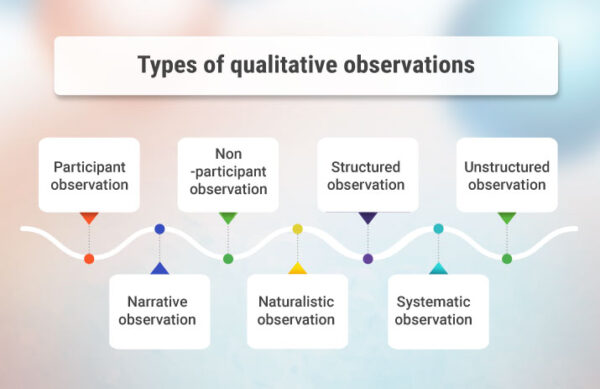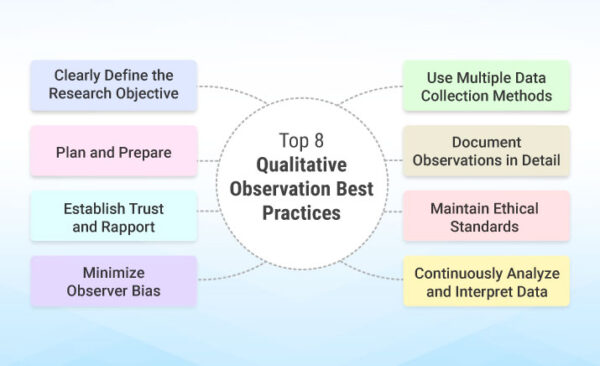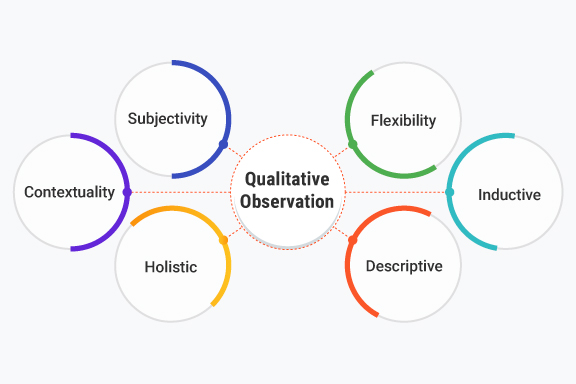What is Qualitative Observation?
Qualitative observation is a research method used to gather non-numerical data by focusing on the qualities, characteristics, and behaviors of a subject. Instead of measuring with numbers or statistics, qualitative observation captures what is seen, heard, felt, smelled, or tasted—providing rich, detailed insights into human behavior, social settings, or cultural phenomena.
This type of observation emphasizes subjective interpretation, contextual understanding, and flexibility. It’s widely used in disciplines like sociology, psychology, anthropology, education, and healthcare, where understanding people’s experiences and environments is key.
Key Characteristics of Qualitative Observation:
- Sensory-based: Uses the five senses to observe and interpret behavior and surroundings.
- Subjective and interpretive: The observer’s perspective plays a key role in analyzing behaviors, emotions, and interactions.
- Context-rich: Captures events in their natural settings to understand the why behind actions and decisions.
- Holistic: Seeks a complete understanding of the situation or environment rather than isolating individual variables.
- Descriptive: Focuses on detailed narratives rather than numerical summaries.
- Inductive: Often leads to new insights, patterns, and theories based on observations rather than testing predetermined hypotheses.
- Flexible: Adapts in real-time as new information or behaviors emerge.
Learn more: What is Qualitative Research?
Types of Qualitative Observations

Qualitative observation typically involves collecting data through techniques such as participant observation, interviews, focus groups, and document analysis. The data collected is often in the form of field notes, transcripts, or recordings, which are then analyzed using various qualitative data analysis techniques such as content analysis, thematic analysis, and discourse analysis.
Below are the several types of qualitative observation methods that researchers use to collect data under different contexts:
1. Participant observation: This type of observation involves the researcher directly participating in the activities or behaviors being studied. The researcher may become a member of the group being studied, or they may observe from a distance while taking notes or recording data. Participant observation is often used in ethnographic research.
2. Non-participant observation: This type of observation involves the researcher observing the activities or behaviors being studied from a distance, without actively participating. The researcher may take notes or record data while observing, and may also conduct interviews or other types of data collection.
3. Structured observation: Structured observation involves observing specific behaviors or activities in a systematic and standardized way. Researchers using structured observation often use a predefined checklist or rating scale to record data on the behaviors being observed.
4. Unstructured observation: Unstructured observation involves observing behaviors or activities without a predefined checklist or rating scale. Researchers using unstructured observation may take detailed notes or record audio or video data to capture the richness and complexity of the behaviors being observed.
5. Narrative observation: Narrative observation involves recording detailed descriptions of events or behaviors as they unfold, often in the form of a narrative or story. Researchers using narrative observation may use audio or video recording to capture the events as they happen, and may also take detailed notes to supplement the recordings.
6. Naturalistic observation: Naturalistic observation involves observing behaviors or activities in their natural setting, without intervening or manipulating the environment. Researchers using naturalistic observation may observe individuals or groups in their natural environment, such as a workplace, school, or home setting.
7. Systematic observation: Systematic observation involves observing behaviors or activities in a systematic and standardized way, using predefined categories or codes to record data. Researchers using systematic observation may use a coding scheme to record data on specific behaviors or events, and may also use software to analyze the data and identify patterns or themes.
Learn more: What is Market Research?
7 Examples of Qualitative Observations
Qualitative observation involves gathering data through detailed descriptions and interpretations of people, behaviors, events, and situations. Here are some examples of qualitative observations:
Example 1: Anthropology
An anthropologist studying a remote tribe’s culture might live among the tribe for an extended period of time, observe their daily activities and behaviors, and take detailed notes to understand their customs, beliefs, and traditions. For example, an anthropologist might observe a tribe’s dance ritual and note the various movements, the accompanying music, and the participants’ emotions.
Example 2: Psychology
A psychologist observing a child’s behavior in a classroom setting might take notes on the child’s interactions with peers, their level of engagement in activities, and their emotions and expressions. For example, a psychologist might observe a child who seems to struggle with social interactions and take note of their facial expressions, tone of voice, and body language.
Example 3: Market research
A market research conducted by a researcher to observe shoppers in a store might take note of shoppers’ behaviors, such as how they navigate the store, which products they pick up and examine, and how they interact with store displays. For example, a market researcher might observe shoppers at a grocery store and note which aisles they spend the most time in and which products they purchase.
Example 4. Sociology
A sociologist studying a community’s social dynamics might observe community gatherings, such as festivals or meetings, and take notes on the interactions between community members, their beliefs and values, and how they communicate with each other. For example, a sociologist might observe a community meeting and take note of the topics discussed, who speaks the most, and how people react to different opinions.
Example 5: Art
An artist observing nature to create a landscape painting might observe the colors, shapes, and textures of the natural environment and use those observations to create a detailed and accurate representation of the landscape. For example, an artist might observe a sunset and take note of the colors of the sky, the shapes of the clouds, and the textures of the landscape.
Example 6: History
A historian studying a particular time period might analyze documents, artifacts, and other primary sources to understand the historical context of the time period and the actions and beliefs of people during that time. For example, a historian might observe a painting from the Renaissance era and analyze the symbolism, style, and technique used to gain insights into the cultural and social context of the time.
Example 7: Content analysis
Content analysis is a qualitative research method that involves analyzing and interpreting the content of texts, such as documents, media, and other forms of communication. Researchers using content analysis aim to identify patterns, themes, and meanings in the content, and to understand how the content reflects or shapes social attitudes and practices.
Learn more: What is a Focus Group?
Top 8 Qualitative Observation Best Practices

Qualitative observation is a valuable research method that allows researchers to gain deep insights into human behavior, social interactions, and phenomena. To ensure the effectiveness and integrity of qualitative observation, it is important to follow best practices. By adopting these practices, researchers can enhance the validity and reliability of their findings. Here are some key best practices for conducting qualitative observation:
1. Clearly Define the Research Objective
Before starting the observation process, it is crucial to clearly define the research objective and identify the specific qualitative research questions or hypotheses to be addressed. Clearly outlining the purpose of the study helps researchers focus their observations and ensures that data collection is relevant to the research goals.
2. Plan and Prepare
Careful planning and preparation are key to conducting successful qualitative observation. Researchers should familiarize themselves with the research context and the individuals or groups being observed. This includes understanding the cultural, social, or contextual factors that may influence behavior. Additionally, researchers should determine the appropriate observation method, whether participant or non-participant, structured or unstructured, based on the research objectives.
3. Establish Trust and Rapport
Building trust and rapport with the observed participants is essential for obtaining accurate and genuine data. Researchers should establish clear communication channels, explain the purpose of the study, and address any concerns or questions participants may have. Creating a comfortable and non-threatening environment encourages participants to behave naturally and increases the validity of the observations.
4. Minimize Observer Bias
Observer bias occurs when the researcher’s presence or expectations influence the behavior of the observed participants. To minimize this bias, researchers should adopt a neutral and non-judgmental stance during the observation process. It is important to be aware of personal beliefs, assumptions, and values that may affect the interpretation of data. Reflexivity, or self-reflection, can help researchers identify and address potential biases.
5. Use Multiple Data Collection Methods
To ensure a comprehensive understanding of the phenomenon under study, researchers should employ multiple data collection methods. This may include direct observation, interviews, field notes, video or audio recordings, photographs, or existing records. Triangulation, the use of multiple sources of data, enhances the validity and reliability of the findings by corroborating information from different perspectives.
6. Document Observations in Detail
Thorough and accurate documentation is critical for qualitative observation. Researchers should record detailed and descriptive field notes during or immediately after the observation session. These notes should capture behaviors, interactions, environmental factors, and any other relevant information. Including verbatim quotes or dialogue can provide rich contextual information and support the analysis process.
7. Maintain Ethical Standards
Ethical considerations are paramount in qualitative observation. Researchers must respect the rights and privacy of the observed participants. Obtaining informed consent is essential, ensuring that participants are aware of the purpose of the study, their rights, and the potential risks or benefits involved. Researchers should maintain confidentiality by anonymizing data and securing it appropriately. Ethical guidelines should be followed throughout the entire research process.
8. Continuously Analyze and Interpret Data
Qualitative observation involves ongoing analysis and interpretation of the collected data. Researchers should engage in constant reflection and analysis to identify patterns, themes, and connections within the observed behaviors. Coding techniques, such as thematic analysis or content analysis, can help organize and categorize the data.
Learn more: What is Customer Feedback?
Most Recent Blogs
Explore the latest innovation insights and trends with our recent blog posts.










